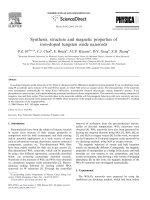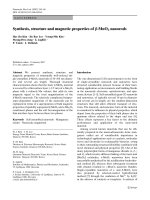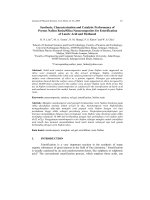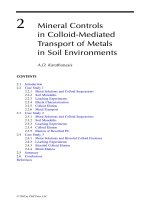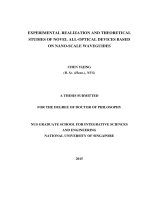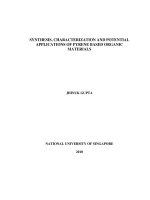SYNTHESIS, STRUCTURE AND CATALYTIC APPLICATION OF NOVEL CARBENE COMPLEXES WITH BENZOTHIAZOLIN 2 YLIDENE LIGANDS 2
Bạn đang xem bản rút gọn của tài liệu. Xem và tải ngay bản đầy đủ của tài liệu tại đây (6.7 MB, 127 trang )
Chapter two: Results and Discussion Introduction
Synthesis, Structure and Catalytic Application of Novel Carbene Complexes with Benzothiazolin-2-ylidene
Ligands
33
Chapter Two
Results and Discussions
2.1 Introduction
This chapter is divided into three parts. Part I (Section 2.2-2.4) describes the
synthesis and coordination chemistry of Pd(II)-NSHC complexes as well as their
applications in catalysis. Part II (Section 2.5-2.6) focuses on the synthesis and
characterization of a range of mixed-ligand carbene complexes with phosphine,
aromatic N-heterocycle, pyridyl and azole ligands. The coordination chemistry and
catalytic activities of N,S- and N,N-NHC Pd(II) complexes are compared. Part III
presents the formation of ring-opening of benzothiazolium salts (Section 2.10), the
coordination of Pt(II)-NSHC-(C^N) complexes (C^N = 2-phenyl-pyridine) (Section
2.11) and the formation of 5-member and 6-member fused ring imidazolium salts via
oxidative addition and reductive elimination (Section 2.12). In the following section,
the synthesis and characterization of benzothiazolium salts will be discussed.
Chapter two: Results and Discussion Part I
Synthesis, Structure and Catalytic Application of Novel Carbene Complexes with Benzothiazolin-2-ylidene
Ligands
34
Part I
Section 2.2: Synthesis and Characterization of Benzothiazolium
Salts – Solvent Free Synthesis
Section 2.3: Synthesis of Mono-, Bis- and Dinuclear Pd(II)
Complexes with 3-benzylbenzothiazolin-2-ylidene ligand and
their Activities toward Mizoroki-Heck Coupling
Section 2.4: Synthesis and Characterization of Pd(II)
Complexes of NSHCs with Pendant and Coordinated Allyl
Functionality and their Suzuki Coupling Activites
Chapter two: Results and Discussion Part I
Synthesis, Structure and Catalytic Application of Novel Carbene Complexes with Benzothiazolin-2-ylidene
Ligands
35
2.2. Synthesis and Characterization of Benzothiazolium Salts
– Solvent Free Synthesis
The preparation of 3-benzylbenzothiazolium bromide (A) (in 65% yield) from
the reaction of benzothiazole with benzyl bromide in DMF at 95 °C has been reported
in the literature.
32
However, only moderate yield was obtained with the use of dry and
high-boiling point DMF as solvent. In this work, when neat benzothiazole is treated
with benzyl bromide in the absence of a solvent at 60 °C (Scheme 2.1), the desired
product A readily precipitates from the liquid mixture, which solidifies toward the end
of the reaction. Washing with Et
2
O gives pure A as an off-white powder in
quantitative yield.
N
S
+
R - X
N
S
H
R
X
Temperature
Salt R X Temperature
A
Br
60 °C
B
Br
60 °C
C
Br
120 °C
D
I
3
100 °C
Scheme 2.1 Synthesis of benzothiazolium salts A-D.
Chapter two: Results and Discussion Part I
Synthesis, Structure and Catalytic Application of Novel Carbene Complexes with Benzothiazolin-2-ylidene
Ligands
36
Table 2.1 Selected
1
H,
13
C NMR and ESI data for A-D.
Salts
1
H NMR (ppm) of
SCHN-proton
a
13
C NMR (ppm) of
SCHN-carbon
a
ESI [M-X]
+
(m/z)
A
12.27 165.1 226
B
11.87 165.0 176
C
12.09 164.9 178
D
11.52 163.1 178
a: measured in CDCl
3
.
The
1
H NMR spectrum of A shows a characteristic downfield resonance at
12.27 ppm for the SCHN proton (SCHN = benzothiazolium proton), indicating the
formation of an azolium salt (Table 2.1). The formation of A is also supported by a
signal at 165.1 ppm in the
13
C NMR spectrum for the SCHN carbon (SCHN = carbon
Fig. 2.1 ORTEP representation of the cation of benzothiazolium salt C
14
H
12
BrNS (A) with
50% thermal ellipsoids and labeling scheme; hydrogen atoms are omitted for clarity.
Chapter two: Results and Discussion Part I
Synthesis, Structure and Catalytic Application of Novel Carbene Complexes with Benzothiazolin-2-ylidene
Ligands
37
carbene precursor) and a base peak at m/z 226 for the azolium cation in the positive
mode ESI mass spectrum (Table 2.1). The identity of A was further confirmed by its
molecular structure (Fig. 2.1 and Table 2.2) elucidated by single-crystal X-ray
diffraction. Compound A is described as a carbene precursor in Section 2.3.
3-(2-Propenyl)benzothiazolium bromide B can be prepared by stirring neat
benzothiazole with a slight excess of allyl bromide at ambient temperature for a few
days.
13
The reaction time can be significantly shortened if the reaction is carried out at
60
◦
C, affording 81% yield in only 12 h (Scheme 2.1). However, higher temperature
should be avoided in order to prevent thermal decomposition. The characteristic
downfield resonance at 11.87 ppm indicates the SCHN proton of the azolium salt
Fig. 2.2 ORTEP representation of the cation of benzothiazolium salt C
10
H
10
BrNS (B) with
50% thermal ellipsoids and labeling scheme; hydrogen atoms are omitted for clarity.
Chapter two: Results and Discussion Part I
Synthesis, Structure and Catalytic Application of Novel Carbene Complexes with Benzothiazolin-2-ylidene
Ligands
38
(Table 2.1). The
13
C NMR signal for this SCHN carbon (SCHN = carbon carbene
precursor) is at 165.0 ppm (Table 2.1). The positive mode of ESI mass spectrum
molecular ion is 176 m/z. The crystal structure of B is shown in Fig. 2.2. The use of
compound B as a carbene precursor will be described in Section 2.4.
3-Propylbenzothiazolium bromide C was prepared in 78 % as a yellow
powder from 1-bromopropane and benzothiazole at 120
◦
C without solvent (Scheme
2.1). The
1
H NMR spectrum of C in CDCl
3
shows a pseudo-sextet at 2.17 ppm and
two sets of triplets at 5.12 and 1.08 ppm characteristic of the propyl substituent. The
downfield resonance at 12.09 ppm for the SCHN proton (Table 2.1) indicates the
formation of a benzothiazolium salt. This is further supported by a
13
C signal at 164.9
ppm for the SCHN carbon (Table 2.1). The positive mode ESI mass spectrum shows a
base peak at m/z = 178 corresponding to the [M − Br]
+
cation (Table 2.1). The
Fig. 2.3 ORTEP representation of the cation of benzothiazolium salt C
10
H
12
BrNS (C) with
50% thermal ellipsoids and labeling scheme; hydrogen atoms are omitted for clarity.
Chapter two: Results and Discussion Part I
Synthesis, Structure and Catalytic Application of Novel Carbene Complexes with Benzothiazolin-2-ylidene
Ligands
39
analysis of C by X-ray single-crystal diffraction confirms the benzothiazolium
structure with N-propyl substituent (Fig. 2.3). The unit cell contains two independent
molecules, which show disorder of the propyl-substituent.
3-Isopropylbenzothiazolium tri-iodide D forms readily from the reaction of
benzothiazole in neat 2-iodopropane (used in excess). Unlike the related 1,3-
diisopropylbenzimidazolin-2-ylidene analogues, iPr
2
-bimyH
+
I
-
,
215
it is isolated in its
tri-iodide form, presumably from iodide and iodine addition reaction. The formation
of iodine, which notably appears as a purple solid on the wall of the condenser at the
end of the reaction, could be traced to photo-activation (from stray light) of alkyl
iodide giving alkyl radical and iodine.
216
The somewhat unsatisfactory yield (32%) is
attributed to base-assisted Hofmann elimination of 3-isopropylbenzothiazolium iodide
to propene and benzothiazole (Scheme 2.2). The yield of D can be raised to 44%
when iodine is added to the reaction. The product salt is soluble in common organic
Fig. 2.4 ORTEP representation of the molecule of benzothiazolium salt C
10
H
12
BrNS (D)
with 50% thermal ellipsoids and labeling scheme; hydrogen atoms are omitted for clarity.
Chapter two: Results and Discussion Part I
Synthesis, Structure and Catalytic Application of Novel Carbene Complexes with Benzothiazolin-2-ylidene
Ligands
40
solvents (e.g. halogenated solvents, methonol, THF, CH
3
CN, DMSO, DMF) and
water, and it is generally more soluble than A-C.
N
S
+
I
N
S
H
I
N
S
H
I
H
H
H
Base
N
S
+
- I
-
N
S
H
I
+ I
2
N
S
H
I
3
I
+
I
2
hv
(a)
(b)
D
2
(c)
(d)
Scheme 2.2 Proposed of benzothiazolium salt D and side products.
The benzothiazolium proton (SCHN) resonance is characteristically downfield
(11.52 ppm) (Table 2.1). It is also more deshielded compared with 1,3-
diisopropylbenzimidazolium iodide, iPr
2
-bimyH
+
I
-
(10.79 ppm),
215
which could be
due to the replacement of nitrogen by a more electropositive sulfur and that there is
only one exocyclic substituent on the heterocycle. The thiazolium carbon (δC = 163.1
ppm) is downfield shifted by ~20 ppm with reference to the azolium carbon in 1,3-
iPr
2
-bimyH
+
X
-
(X = I, 139.5;
215
X = Br, 140.7 ppm).
217
The positive-mode ESI mass
spectrum shows a principal peak at m/z = 178 corresponding to the thiazolium cation.
Chapter two: Results and Discussion Part I
Synthesis, Structure and Catalytic Application of Novel Carbene Complexes with Benzothiazolin-2-ylidene
Ligands
41
Salt D is used as a carbene precursor in preparing Pd(II) mononuclear and dinuclear
NSHC- complexes. The results will be discussed in Section 2.7 and 2.8. X-ray crystal
structure diffraction analysis of D has confirmed the identity of 3-isopropyl
substituted benzothiazolium cation with the linear tri-iodide anion (Fig. 2.4).
Under solventless conditions, benzothiazole readily reacts with alkyl halides
give A-D, which are air-stable that can be used conveniently.
Chapter two: Results and Discussion Part I
Synthesis, Structure and Catalytic Application of Novel Carbene Complexes with Benzothiazolin-2-ylidene Ligands
42
Table 2.2 Selected bond lengths [Å] and angles [deg] for A-D.
Bond Lengths
[Å]
A
B
C
D
Molecule a
Molecule b
S1-C1
1.690 (2)
1.684(3)
1.683(4)
S2-C11
1.678(3)
1.681(3)
N1-C1
1.314(2)
1.315(3)
1.317(4)
N2–C11
1.325(4)
1.311(4)
N1-C8
1.483(2)
1.481(3)
1.479(5)
N2–C18
1.473(4)
1.498(3)
C8-C9
-
1.500(3)
1.550(8)
C18-C19
1.556(8)
1.519(4)
C9-C10
-
1.309(3)
1.541(9)
C19-C20
1.529(8)
-
C8-C10
-
-
-
-
-
1.514(5)
Angles [deg]
N1-C1-S1
114.14(14)
114.58(17)
114.6(3)
N2–C11–S2
114.6(2)
115.0(2)
C1-N1-C8
123.63(16)
123.95(18)
123.2(3)
C11–N2–C18
122.8(3)
124.4(2)
C9-C8-C10
-
-
-
-
-
112.9(3)
N1-C8-C9
-
110.59(16)
109.6(4)
N2-C18-C19
108.2(4)
109.1(2)
N1-C8-C10
-
-
111.3(2)
I2-I1-I3
-
-
177.95(8)
Chapter two: Results and Discussion Part I
Synthesis, Structure and Catalytic Application of Novel Carbene Complexes with Benzothiazolin-2-ylidene
Ligands
43
2.3 Synthesis of Mono-, Bis- and Dinuclear Pd(II) Complexes with 3-
benzylbenzothiazolin-2-ylidene ligand and their Activities toward
Mizoroki-Heck Coupling
The synthetic pathway and structure of mono-, bis- and dinuclear Pd(II)-
NSHC complexes are discussed. This will be followed by their catalytic application in
Mizoroki-Heck reaction.
2.3.1 Synthesis of Pd(II) N, S-heterocyclic Carbene Complexes
The reaction of 3-benzylbenzothiazolium bromide and Pd(OAc)
2
gives the
Pd(II)-NSHC complex in a one-pot synthesis. This is based on the methodology
developed for Pd(II) dicarbene complexes by using in situ deprotonation of azolium
salts with basic metal precursors.
33, 218
Calò et. al. used a similar strategy to prepare a
Pd(II) bis-(benzothiazolin-2-ylidene) complex from 3-methylbenzothiazolium iodide
and Pd(OAc)
2
in THF.
12(a)
The orange bis(NSHC) complex cis-[PdBr
2
(NSHC)
2
] (2.1) was prepared in
good yield (91%) from Pd(OAc)
2
and 2 equivalents of A in refluxing CH
3
CN
(Scheme 2.3). The positive mode ESI mass spectrum is dominated by an isotopic
pattern centered at m/z = 637 corresponding to a monocation formed upon bromide
dissociation from 2.1. At ambient temperature, the
1
H NMR spectrum (DMSO-d
6
) of
2.1 exhibits broad signals that are slightly shifted upfield compared to the values
observed for the benzothiazolium salt A. One broad singlet is noted at 6.34 ppm for
both methylene groups, indicating a relatively high energy barrier for the rotation
around the Pd-C bond arising from the bulky benzyl substituent on the carbene ligand.
The
13
C carbon carbene resonance at 203.8 ppm is significantly more upfield than the
Chapter two: Results and Discussion Part I
Synthesis, Structure and Catalytic Application of Novel Carbene Complexes with Benzothiazolin-2-ylidene
Ligands
44
N
S
H
Br
+ 2 Pd(OAc)
2
CH
3
CN
S
N
N
S
Pd
reflux
- 2 HOAc
Br Br
N
S
N
S
Pd
Pd
CH
3
CN
DMF
N
S
Pd
N
S
PdNCCH
3
DMF
N
S
H
OAc
+ 2
DMSO, 70
o
C
- 2 HOAc
4
Br
Br
A
2.1
2.2 (a)
2.3 2.4
Br
Br
Br
Br
Br
Br
2 2
2
Scheme 2.3 Synthesis of Pd(II) carbene complexes 2.1-2.4.
analogous resonance observed by Calò et. al. in their trans-complex 1.45 (210.5
ppm),
12(a)
which points to a cis-configuration of the carbene ligands in 2.1. The
identity of 2.1 has been established, although its carbon analyses in microanalysis
remains unsatisfactory due to solvent molecules contained in the crystal lattice. When
the reaction is carried out in DMSO at 70 °C, a bromo-bridged dinuclear Pd(II)
complex [PdBr
2
(NSHC)]
2
(2.2(a)) forms, which shows a 1:1 carbene-to-metal ratio.
Chapter two: Results and Discussion Part I
Synthesis, Structure and Catalytic Application of Novel Carbene Complexes with Benzothiazolin-2-ylidene
Ligands
45
The absence of the downfield signal for the SCHN proton in the
1
H NMR spectrum
indicates a successful complexation of 2.2(a). Although the carbene resonance could
not be detected in the
13
C NMR spectrum, the FAB mass spectrometric data shows a
peak that corresponds to the dinuclear cation (m/z = 903 corresponding to [2.2(a) -
Br]
+
). These results also suggest that the formation of a dinuclear vs dicarbene
complex is driven by the solvent instead of substrate stoichiometry. The solvent has
an additional effect on the formation of dinuclear complex. In the presence of donor
solvents such as CH
3
CN or DMF, bridge cleavage readily occurs, giving the
mononuclear solvate complexes trans-[PdBr
2
(NSHC)(CH
3
CN)] (2.3) and trans-
[PdBr
2
(NSHC)(DMF)] (2.4), as shown in Scheme 2.3. The
13
C carbon carbene signals
of 2.3 and 2.4 occur at 191.5 and 191.9 ppm, respectively.
2.3.2 Molecular Structures
The molecular structures of complexes (2.1-2.4) have been determined by X-
ray single-crystal diffraction. Selected bond lengths and bond angles are summarized
in Table 2.3. The structure of complex 2.1 reveals an essentially mononuclear square-
planar Pd(II) coordinated by two NSHCs and two bromo ligands in a cis-arrangement
(Fig. 2.5).
Table 2.3 Selected bond lengths [Å] and angles [deg] for complexes 2.1-2.4.
2.1 2.2(a) 2.3 2.4
Bond Lengths [Å]
Pd(1)-C(1) 1.971(5) 1.936(7) 1.936(3) 1.921(2)
Pd(1)-C(15) 1.976(4) - - -
Pd(1)-Br(1) 2.454(6) 2.458(1) 2.423(4) 2.438(4)
Pd(1)-Br(2) 2.469(6) 2.539(1) 2.448(4) 2.424(4)
Pd(1)-Br(3) - 2.389(1) - -
Chapter two: Results and Discussion Part I
Synthesis, Structure and Catalytic Application of Novel Carbene Complexes with Benzothiazolin-2-ylidene
Ligands
46
Pd(1)-N(2) - - 2.063(3) -
Pd(1)-O(1) - - - 2.101(18)
Pd(2)-C(15) - 1.960(8) - -
Pd(2)-Br(1) - 2.532(1) - -
Pd(2)-Br(2) - 2.445(1) - -
Pd(2)-Br(4) - 2.415(1) - -
O(1)-C(15) - - - 1.230(3)
S(1)-C(1) 1.713(5) 1.712(8) 1.699(3) 1.710(3)
S(2)-C(15) 1.710(5) 1.709(8) - -
N(1)-C(1) 1.324(6) 1.323(9) 1.330(3) 1.333(3)
N(1)-C(8) 1.468(6) 1.477(1) 1.467(3) 1.465(3)
N(2)-C(15) 1.327(6) - 1.119(4) 1.307(3)
N(2)-C(16) - - - 1.452(3)
N(2)-C(17) - - - 1.434(4)
N(2)-C(22) 1.473(6) - - -
N(3)-C(15) - 1.31(1) - -
N(3)-C(22) - 1.50(1) - -
C(15)-C(16) - - 1.458(5) -
Angles [deg]
Br(1)-Pd(1)-Br(2) 91.21(2) 87.1(4) - -
Br(2)-Pd(2)-Br(1) - 87.54(4) - -
Br(3)-Pd(1)-Br(2) - 94.17(4) - -
Br(4)-Pd(2)-Br(1) - 91.79(4) - -
C(1)-N(1)-C(8) 122.7(4) 123.5(7) 123.8(2) 122.6(2)
C(1)-Pd(1)-Br(1) 88.95(13) 92.1(2) 90.15(9) 88.0(7)
C(1)-Pd(1)-Br(2) - - 88.43(9) 90.68(7)
C(1)-Pd(1)-Br(3) - 86.6(2) - -
C(1)-Pd(1)-C(15) 89.74(19) - - -
C(15)-N(2)-C(16) - - - 121.4(3)
C(15)-N(2)-C(17) - - - 120.5(2)
C(15)-N(2)-C(22) 123.0(4) - - -
C(15)-N(2)-Pd(1) - - 175.9(3) -
C(15)-N(3)-C(22) - 123.9(7) - -
C(15)-O(1)-Pd(1) - - - 127.73(19)
C(15)-Pd(1)-Br(2) 90.18(14) - - -
C(15)-Pd(2)-Br(2) - 90.0(3) - -
C(15)-Pd(2)-Br(4) - 90.7(3) - -
Chapter two: Results and Discussion Part I
Synthesis, Structure and Catalytic Application of Novel Carbene Complexes with Benzothiazolin-2-ylidene
Ligands
47
C(17)-N(2)-C(16) - - -
118.1(2)
N(1)-C(1)-Pd(1) 129.20(4) 130.00(6) - 129.48(19)
N(1)-C(1)-S(1) 110.90(3) 111.10(5) 111.6(2) 111.31(18)
N(2)-C(15)-C(16) - - 178.3(5) -
N(2)-C(15)-Pd(1) 131.10(4) - - -
N(2)-C(15)-S(2) 110.20(3) 111.70(6) - -
N(2)-Pd(1)-Br(1) - - 91.56(9) -
N(2)-Pd(1)-Br(2) - - 89.88(9) -
N(3)-C(15)-Pd(2) - 128.80(6) - -
O(1)-C(15)-N(2) - - - 123.8(3)
O(1)-Pd(1)-Br(1) - - - 93.88(5)
O(1)-Pd(1)-Br(2) - - - 87.58(5)
Pd(1)-Br(1)-Pd(2) - 92.60(4) - -
Pd(2)-Br(2)-Pd(1) - 92.76(4) - -
S(1)-C(1)-Pd(1) 119.80(3) 118.90(4) 119.97(15) 119.12(13)
S(2)-C(15)-Pd(1) 118.70(2) - - -
S(2)-C(15)-Pd(21) - 119.40(5) - -
The NSHC planes are oriented nearly perpendicularly to the PdC
2
Br
2
coordination planes with dihedral angles of 71.2° and 77.5° as a mean to minimize
Fig. 2.5 ORTEP representation of the molecule [PdBr
2
(NSHC)
2
] (2.1) with 50% thermal
ellipsoids and labeling scheme; hydrogen atoms are omitted for clarity.
Chapter two: Results and Discussion Part I
Synthesis, Structure and Catalytic Application of Novel Carbene Complexes with Benzothiazolin-2-ylidene
Ligands
48
interligand interactions between the carbenes. The Pd-C bond distances (1.971(5) and
1.976(4) Å) are notably shorter than those found in trans-diiodobis-(3-
methylbenzothiazolin-2-ylidene)Pd(II) 1.45 (2.06(3) Å),
12(a)
suggesting a stronger Pd-
C bond in cis-complexes. These bonds are also shorter than those found in a cis-
dibromo-bis(benzimidazolin-2-ylidene)Pd(II) complex (1.996 Å).
219
The other
complexes studied herein have even shorter, and presumably stronger, Pd-C bonds.
The Pd-Br bond lengths (2.454(6) and 2.469(6) Å), on the other hand, are comparable
to other cis-dibromobis-(carbene) complexes of Pd(II)
.
219
The N(1)-C(1)-S(1) angle of
the ligand precursor A (114.14°) has contracted to 110.9 Å upon coordination to give
2.1. Other structural parameters remain unchanged, indicating that the coordination to
the Pd center mainly affects the carbene carbon as well as the neighboring nitrogen
and sulfur atoms.
The dimeric molecular structure of the CHCl
3
solvate of 2.2(a) was also
confirmed by an X-ray single-crystal diffraction technique (Fig. 2.6). Each of the two
Pd(II) centers is coordinated by one carbene, one terminal bromo, and two bridging
µ
-
Fig. 2.6 ORTEP representation of the molecule [PdBr
2
(NSHC)
2
] (2.2(a)) with 50%
thermal ellipsoids and labeling scheme; hydrogen atoms are omitted for clarity.
Chapter two: Results and Discussion Part I
Synthesis, Structure and Catalytic Application of Novel Carbene Complexes with Benzothiazolin-2-ylidene
Ligands
49
bromo ligands in a square-planar fashion. The metal can be stabilized by the basic
bridging bromide. The two carbene ligands in 2.2(a) are syn to each other across the
flat dinuclear frame. The dihedral angles between both carbene ring planes and the
coordination plane are 68.8° and 74.7° respectively. Both 3-benzyl substituents are on
the same side of the metal coordination plane. The Pd-C bonds (1.936(7) and 1.960(8)
Å) are even shorter and stronger than those in 2.1, again indicating higher Lewis
acidity of the Pd(II) centers in 2.2(a) as compared to that in 2.1. The six Pd-Br bonds
can be divided into three different sets with significantly different lengths. The
terminal Pd-Br bonds are the shortest (2.389(1)-2.415(1) Å), whereas the bridged
bonds that are trans to the carbenes are the longest (2.539(1)-2.532(1) Å).
The bridging Pd-Br bonds are readily cleaved by CH
3
CN and DMF. This is
consistent with the fact that the Pd-Br bonds are weak. The cleavage of 2.2(a) with
the two coordinating solvents afford complexes 2.3 (CH
3
CN) and 2.4 (DMF)
Fig. 2.7 ORTEP representation of the molecule [PdBr
2
(NSHC)(CH
3
CN)] (2.3) with 50%
thermal ellipsoids and labeling scheme; hydrogen atoms are omitted for clarity.
Chapter two: Results and Discussion Part I
Synthesis, Structure and Catalytic Application of Novel Carbene Complexes with Benzothiazolin-2-ylidene
Ligands
50
respectively, which also have been structurally characterized by single-crystal X-ray
diffraction. The molecular structures of 2.3 and 2.4 are depicted in Fig. 2.7 and 2.8
respectively. Both are square-planar mononuclear and monocarbene Pd-(II)
complexes with a weakly coordinated solvent molecule occupying the position trans
to the carbene ligand. The Pd-C bond lengths are 1.936(3) and 1.921(2) Å for
complexes 2.3 and 2.4 respectively. These Pd-C bond distances are shorter than those
in 2.1, which again reflect a more Lewis acidic metal center. The dihedral angles
between carbene ring planes and the PdBr
2
CH
3
CN or PdBr
2
DMF coordination planes
are 76.5° and 73.8° respectively. The adjacent 3-benzyl rings are oriented almost
orthogonally to the benzothiazolyl rings with C(1)-N(1)-C(8) angles of 91.2° and
95.3° for complexes 2.3 and 2.4 respectively.
Fig. 2.8 ORTEP representation of the molecule [PdBr
2
(NSHC)(DMF)] (2.4) with 50%
thermal ellipsoids and labeling scheme; hydrogen atoms are omitted for clarity.
Chapter two: Results and Discussion Part I
Synthesis, Structure and Catalytic Application of Novel Carbene Complexes with Benzothiazolin-2-ylidene
Ligands
51
2.3.3 Mizoroki-Heck Coupling Reaction
With the isolation and characterization of this series of N,S-heterocyclic
carbenes complexes, it is now possible to directly compare the catalytic activities of
mono- and biscarbene as well as mono- and dinuclear Pd(II) complexes. The
Mizoroki-Heck coupling reactions of various aryl bromides and chlorides with tert-
butyl acrylate catalyzed by complexes 2.1-2.4 lead to the corresponding cinnamates
(Table 2.4). Complexes 2.1-2.4 are air-stable, and hence there is no necessity for
handling these complexes in a glovebox. The dicarbene complex 2.1 is efficient
toward the coupling reaction between 4-bromobenzaldehyde or 4-bromoacetophenone
and the acrylate, giving quantitative conversion (100%) (Table 2.4, Entries 1-6).
Slightly lower (75-79%) conversions were observed when deactivated aryl bromides
were used (Table 2.4, Entries 7-9). To further investigate the effect of the catalyst
loading on the conversion rate, coupling of 4-bromobenzaldehyde with the acrylate
using complex 2.1 as precatalysts was examined. As shown in entries 1-4, the loading
of catalyst from 1 mol % to 0.05 mol % gave quantitative conversion (≥ 95%).
Table 2.4 Mizoroki-Heck coupling reactions
a
catalyzed by complexes 2.1- 2.4.
R X
+
Solvent, NaOAc
O
O
R
[Pd]
-HX
X = Br, Cl
R = CHO, CH
3
CO, CH
3
O, OH, CH
2
OH, CN
O
O
Entry [Pd]
Cat.
load
[mol
%]
Aryl halide Solvent
t
[h]
Temp
[ºC]
Conver-
sion
b
[%]
1
2.1
1
4-bromobenzaldehyde
DMF
22
100
100
2
2.1
0.5
4-bromobenzaldehyde
DMF
22
100
100
3
2.1
0.25
4-bromobenzaldehyde
DMF
22
100
99
Chapter two: Results and Discussion Part I
Synthesis, Structure and Catalytic Application of Novel Carbene Complexes with Benzothiazolin-2-ylidene
Ligands
52
4
2.1
0.05
4-bromobenzaldehyde
DMF
22
100
95
5
2.1
1
4-bromobenzaldehyde
Toluene
17
100
18
6
2.1
1
4-bromoacetophenone
DMF
21
110
98
7
2.1
1
4-bromoanisole
DMF
21
110
79
8
2.1
1
4-bromophenol
DMF
21
110
75
9
2.1
1
4-
bromophenylmethanol
DMF
21
110
77
10
2.2(a)
1
4-bromobenzaldehyde
Toluene
17
100
17
11
2.2(a)
1
4-bromoacetophenone
Toluene
17
100
47
12
2.2(a)
1
4-bromoanisole
Toluene
17
100
25
13
2.2(a)
1
4-bromoanisole
Toluene
c
21
110
25
14
2.3
1
4-bromobenzaldehyde
CH
3
CN
21
60
10
15
2.3
1
4-bromobenzaldehyde
CH
3
CN
c
21
60
19
16
2.3
1
4-bromobenzaldehyde
DMF
17
110
95
17
2.3
1
4-bromobenzaldehyde
Toluene
17
100
19
18
2.3
1
4-bromoacetophenone
CH
3
CN
21
60
30
19
2.3
1
4-bromoacetophenone
CH
3
CN
c
21
60
54
20
2.3
1
4-bromoanisole
CH
3
CN
21
60
29
21
2.3
1
4-bromoanisole
CH
3
CN
c
21
60
30
22
2.3
1
4-bromoanisole
DMF
17
110
53
23
2.3
1
4-bromophenol
CH
3
CN
21
60
7
24
2.3
1
4-
bromophenylmethanol
CH
3
CN
21
60
32
25
2.4
1
4-bromobenzaldehyde
DMF
19
110
100
26
2.4
1
4-bromoacetophenone
DMF
19
110
100
27
2.4
1
4-bromoanisole
DMF
19
110
99
28
2.4
1
4-bromophenol
DMF
19
110
16
29
2.4
1
4-
bromophenylmethanol
DMF
19
110
12
30
2.1
1
4-chlorobenzaldehyde
DMF
42
100
8
31
2.1
1
4-chloroacetophenone
DMF
42
100
5
32
2.1
1
4-chlorobenzonitrile
DMF
42
100
5
33
2.1
1
4-chlorobenzaldehyde
DMF
d
20
110
8
34
2.1
1
4-chloroacetophenone
DMF
d
20
110
5
35
2.1
1
4-chlorobenzonitrile
DMF
d
20
110
8
36
2.4
1
4-chlorobenzaldehyde
DMF
42
100
8
37
2.4
1
4-chloroacetophenone
DMF
42
100
4
38
2.4
1
4-chlorobenzonitrile
DMF
42
100
6
Chapter two: Results and Discussion Part I
Synthesis, Structure and Catalytic Application of Novel Carbene Complexes with Benzothiazolin-2-ylidene
Ligands
53
39
2.4
1
4-chlorobenzaldehyde
DMF
d
20
110
17
40
2.4
1
4-chloroacetophenone
DMF
d
20
110
5
41
2.4
1
4-chlorobenzonitrile
DMF
d
20
110
10
a
1 mmol of Aryl halide, 1.5 mmol of base, 1.2 mmol of tert-butyl acrylate, Reaction
conditions generally not optimized.
b
Conversions were determined by GC/MS.
c
With
addition of 1.5 mmol of NaO
2
CH.
d
With addition of 1.5 mmol [N(n-C
4
H
9
)
4
]Br.
A kinetic plot of the coupling reaction between electron-withdrawing 4-
bromobenzaldehyde and tert-butyl acrylate under 1 mol % catalyst 2.1 is given in Fig.
2.9. The reaction is essentially complete within 3 h (monitored by
1
H NMR
spectroscopy), whereas up to 60% of product is formed within the first 20 min.
Complex 2.1 thus promotes a remarkably fast coupling, although the reaction profile
shows an induction period for the first 10 min upon mixing. It suggests a fairly rapid
reduction of Pd(II) to the catalytically active Pd(0). The turnover points to an initially
sluggish product formation followed by a marked increase in turnover with time. A
similar activation step has been reported for cis-diiodo-bis-(N,N’-
dimethylbenzimidazolin-2-ylidene)Pd(II).
17
When DMF is replaced by, for example,
0
20
40
60
80
100
0
10
20
35
55
85
115
145
205
t [min]
x [%]
Fig. 2.9. Concentration/time diagram (amount of substance x [%], time t [min]) for the
Mizoroki-Heck olefination of 4-bromobenzaldehyde with tert-butyl acrylate to form tert-butyl
(E)-4-formylcinnamate (■) catalyzed by complex 2.1.
Chapter two: Results and Discussion Part I
Synthesis, Structure and Catalytic Application of Novel Carbene Complexes with Benzothiazolin-2-ylidene
Ligands
54
toluene, the conversion decreases markedly to only 18% (Table 2.4, Entry 5).
The catalytic efficiency of the dinuclear 2.2(a) is the poorest among the
complexes studied and unsatisfactory in toluene (Table 2.4, Entries 10-13), giving the
conversion of 47% (Table 2.4, Entry 11). This could be attributed to its high stability
in toluene; the poor donor character of toluene also does not cleave the Pd(II)-NSHC
dinuclear complex. Use of DMF as solvent for 2.2(a) effectively gives 2.4. The
catalytic activities of 2.3 were examined in three different solvents, viz., CH
3
CN,
DMF, and toluene (Table 2.4, Entries 14-24). The reaction was compared with those
complexes 2.1-2.2(a) and 2.4. The best activity is observed when DMF was used as
solvent, giving 95% conversion of product with 4-bromobenzaldehyde as substrate
(Table 2.4, Entry 16). In CH
3
CN, the highest conversion recorded is 54% (Table 2.4,
Entry 19) when sodium formate is added (Table 2.4, Entries 15, 19, and 21). The
reaction carried out in toluene gives only 19% (Table 2.4, Entry 17). The high donor
character of DMF appears to provide the best catalyst stability. The catalytic activity
of 2.3 depends significantly on the temperature and solvent. In most cases, catalyst
decomposition was observed, giving rise to palladium black. These results suggest
that 2.3 is unstable during catalysis which could explain some low activities. The
above results suggest some benefits of using DMF as a solvent or ligand solvate.
When the DMF complex 2.4 is used, quantitative conversion (≥ 99%) of 4-
bromobenzaldehyde, 4-bromoacetophenone, and 4-bromoanisole are obtained (Table
2.4, Entries 25-27). However, this does not apply to the deactivated aryl bromides
such as 4-bromophenol and 4-bromophenylmethanol, which give low conversions
(Table 2.4, Entries 28 and 29). The catalytic activity of complexes 2.1 and 2.4 with
activated aryl chlorides and deactivated aryl chlorides such as 4-chlorobenzaldehyde,
4-chloroacetophenone, and 4-chlorobenzonitrile were studied. However, the observed
Chapter two: Results and Discussion Part I
Synthesis, Structure and Catalytic Application of Novel Carbene Complexes with Benzothiazolin-2-ylidene
Ligands
55
catalytic activity is low (conversion below 10% and improved slightly, <20%, when
tetrabutylammonium bromide was added) (Table 2.4, Entries 30-41). The catalytic
activity of oxalin-2-ylidene Pd(II) complexes also showed low conversion for the
activated aryl chloride.
220
This is possibly due to the less electronegative sulfur as
opposed to nitrogen in benzothiazolin-2-ylidene in the Pd(II)-NSHC complexes
compared to Pd(II)-NNHC. Complexes 2.1 and 2.4 show a greater catalytic activity
than complexes 2.2(a) and 2.3. The catalytic activities of complexes 2.1 and 2.4 are
comparable with Caló’s bis(2,3-dihydro-3-methylbenzohiazole-2-ylidene)Pd(II)
diiodide complex when the reactions are carried out in molten tetrabutylammonium
bromide.
12(a)
2.3.4 Conclusion
A simple and direct method for the synthesis of the 3-benzylbenzothiazolium
salt and the related benzothiazolin-2-ylidene complexes of Pd(II) was developed.
Treatment of A with Pd(OAc)
2
in CH
3
CN affords the bis(carbene) complex cis-
[PdBr
2
(NSHC)
2
] (2.1) (NSHC= 3-benzylbenzothiazolin-2-ylidene). In DMSO, this
reaction yields an unprecedented dinuclear N,S-heterocyclic carbene complex
[PdBr
2
(NSHC)]
2
(2.2). Complex 2.2 undergoes bridge cleavage reactions with
CH
3
CN and DMF to give the mononuclear and solvated monocarbene complexes
trans-[PdBr
2
(NSHC)(Solv)] [Solv = CH
3
CN (2.3) and DMF (2.4)]. The catalytic
activities of 2.1-2.4 toward Mizoroki-Heck coupling reactions of aryl bromides with
tert-butyl acrylate are described and compared.
Chapter two: Results and Discussion Part I
Synthesis, Structure and Catalytic Application of Novel Carbene Complexes with Benzothiazolin-2-ylidene
Ligands
56
2.4 Synthesis and Characterization of Pd(II) Complexes of
NSHCs with Pendant and Coordinated Allyl Functionality
and their Suzuki Coupling Activities
A simple pathway to mono- and bis- as well as dinuclear Pd(II) complexes
with 3-benzylbenzothiazolin-2-ylidene ligand was discussed in the previous section.
In this section, a functional side-chain [3-(2-propenyl)benzothiazolium-2-ylidene
ligand] is introduced in the synthesis of Pd(II)-NSHC complexes. Apart from the
general tuning of electronic properties, a donor-functionalized arm in the ligand core
could enhance the potential for hemilability. The synthesis and structural
characterizations of the novel allyl derivatized NSHC Pd(II) complexes and early
studies of their activity in Suzuki–Miyaura coupling toward aryl bromides and
chlorides are discussed. The mixed dicarboxylato-NSHC complexes with the 3-(2-
propenyl)benzothiazolium-2-ylidene ligand is also discussed.
2.4.1 Synthesis and Characterization of Pd(II) Complexes (cis-, trans-
isomers and dicarboxylato-bis(NSHC) Pd(II) Complexes)
The reaction of Pd(OAc)
2
with precursor B in a 1 : 2 ratio in refluxing CH
3
CN
gives a mixture of cis- and trans-Pd(II) bis(carbene) complexes as major products in
an overall yield of 92% (Scheme 2.4). The two geometrical isomers, cis-2.5 and
trans-2.5 have different solubility in CH
3
CN and can be separated by a simple
filtration.
Chapter two: Results and Discussion Part I
Synthesis, Structure and Catalytic Application of Novel Carbene Complexes with Benzothiazolin-2-ylidene
Ligands
57
N
S
H
Br
+ Pd(OAc)
2
cis-2.5
N
S
Pd
N
S
B
N
S
Pd
N
S
Pd
S
N
2
CH
3
CN, 70
o
C
- HOAc
2.6 2.7
trans-2.5
Br
Br
Br
Br
Br
Br
N
S
Pd
S N
Br
Br
Scheme 2.4 Synthesis of Pd(II) carbene complexes trans-2.5, cis-2.5, 2.6 and 2.7.
The insoluble (in CH
3
CN) complex cis-[PdBr
2
(NHSC)
2
] (cis-2.5, NSHC = 3-(2-
propenyl)benzothiazolin-2-ylidene) can be isolated in a moderate yield of 32% as a
white and air stable solid. Column chromatography on the filtrate mixture afforded
trans-[PdBr
2
(NHSC)
2
] (trans-2.5) as an orange powder in 60% yield. The positive
mode ESI mass spectra for both isomers is dominated by an isotopic pattern centered
at m/z = 537 corresponding to [2.5 − Br]
+
. Their
1
H NMR spectra recorded in DMSO-
d
6
are also similar with only slight differences in chemical shifts. For both complexes,
the absence of the downfield signal for the SCHN proton characteristic for B indicates
a successful formation of carbene complexes. The NCH
2
resonance for cis-2.5 gives
rise to a broad doublet at 5.92 ppm, whereas for trans-2.5 two very broad signals are
